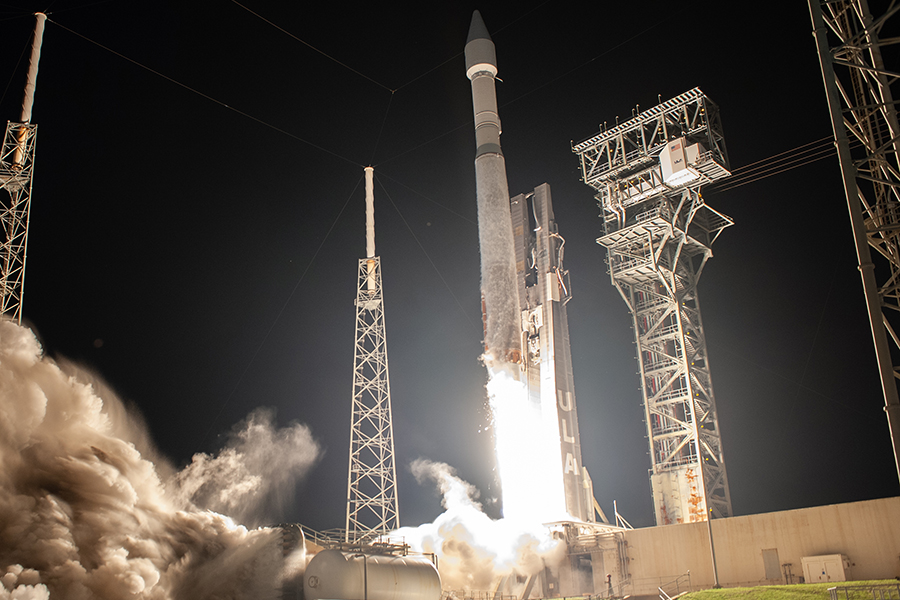Lucy mission utilizes talents of AAE alumni

Two AAE alumni played key roles in the Oct. 16 Lucy space flight, a first-of-its kind mission for NASA that will explore Jupiter’s elusive Trojan asteroids. Lockheed Martin built the mission’s spacecraft.
Scientists believe these asteroids are some of the oldest remnants from the formation of the solar system 4.5 billion years ago.
The two alumni, both employed by Lockheed Martin, are Divinaa Burder (BSAAE ‘14) and Nipuna Jayakody (BSAAE ‘12, MSAAE ‘14). Burder is a systems integration and test engineer, and Jaykody works as a software systems engineer.
Burder developed test scripts and procedures and provided console support during real-time simulation and on-spacecraft testing of the various systems on Lucy. She also supported launch site operations at Cape Canaveral prior to the launch.
Jayakody, whose role was required as part of the Lucy mission, worked in four main software domains: flight software (spacecraft brain); simulation software (used to test flight software responses in a simulated environment); test support software (used to interact with the spacecraft while on the assembly and test floor; and ground data (used to manage, interpret and report spacecraft telemetry).
In short, he ensured that the software produced in those domains was designed, coded and verified to meet mission and customer needs.
Burder was recruited from a different business area at Lockheed Martin to join the Lucy team full time.
“This transition was encouraged by my then-team leaders, as I was better suited to and highly interested in working on deep space missions,” Burder said.
Lucy will help scientists discover more about the universe’s origins than ever before, as the Discovery-class mission endeavors to take the first close-up images of these asteroids, according to Lockheed Martin.
Over the course of 12 years, Lucy will visit eight asteroids - one in the main belt between Mars and Jupiter, and seven Trojan asteroids leading and trailing Jupiter in its orbit.

Jayakody is quick to give credit to his Purdue training, noting the multitude of opportunities for projects and hands-on experiences, such as design/build/fly and capstone classes.
“That’s where I built my skills working as a team, understanding subsystem needs, how to balance conflicting requirements and how to coordinate solutions,” Jayakody said.
The design theory and methods for aerospace systems material taught by William Crossley, the J. William Uhrig and Anastasia Vournas Head of Aeronautics and Astronautics, is what Jayakody said he uses most often.
For now, Jayakody’s work with Lucy is complete, as he has moved on to another position.
“My role had a shelf life through the end of Phase D (assembly, test and launch), but it’s entirely possible that our paths will cross again,” Jayakody said.
Burder, who also holds a master’s degree in aeronautics from Embry-Riddle Aeronautical University, is currently working on her PhD in astrodynamics at the University of Colorado - Boulder. She says her bachelor’s work at Purdue helped her develop critical thinking skills to solve difficult problems as well as the value of teamwork.
“During my undergraduate, I learned the importance of perseverance, hard work and having a reliable support system, all of which are necessary for the success of a mission,” she said.
Even in the midst of the COVID-19 pandemic and all of the challenges that arose as a result, Burder calls Lucy “an amazing experience.”
“(The pandemic) required extensive changes to the Lucy ATLO (Assembly, Test and Launch Operations), a traditionally very hands-on portion for the entire team, so that we could create a safe environment for all of us,” Burder said. “I’m so proud of everything we’ve accomplished.”
Her work, like Jayakody’s, came to an end after the launch, and she is now working on mission design for the Deep Space Exploration Advanced Programs and the Human Lander Systems (HLS) Appendix N studies.
Jayakody also noted the pandemic and how the team still managed to launch on schedule — all on top of the normal challenges of developing a custom spacecraft.
“I’m extremely proud and humbled to be part of the Lucy team,” he said.
